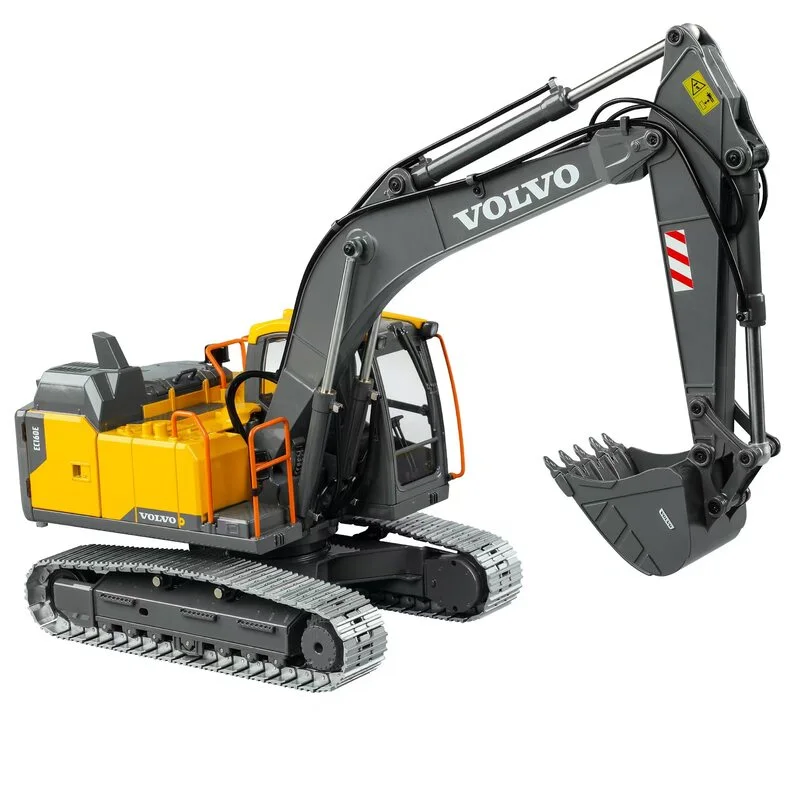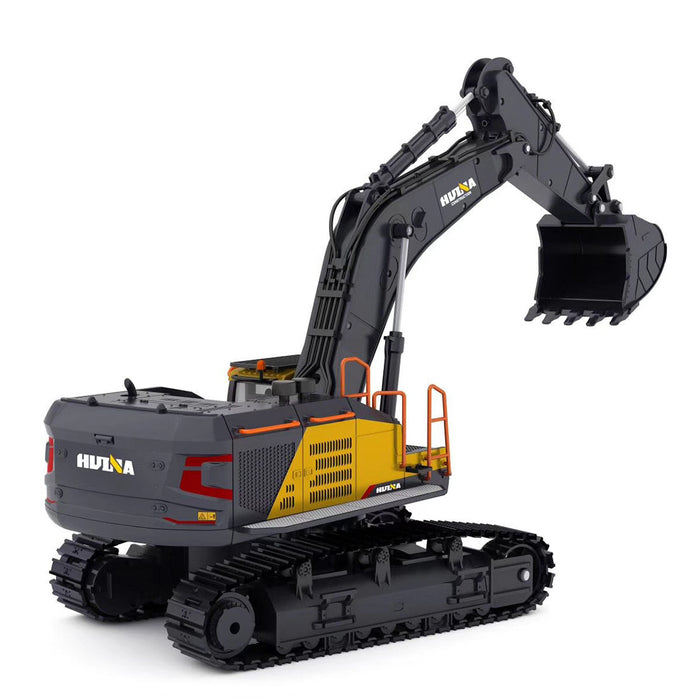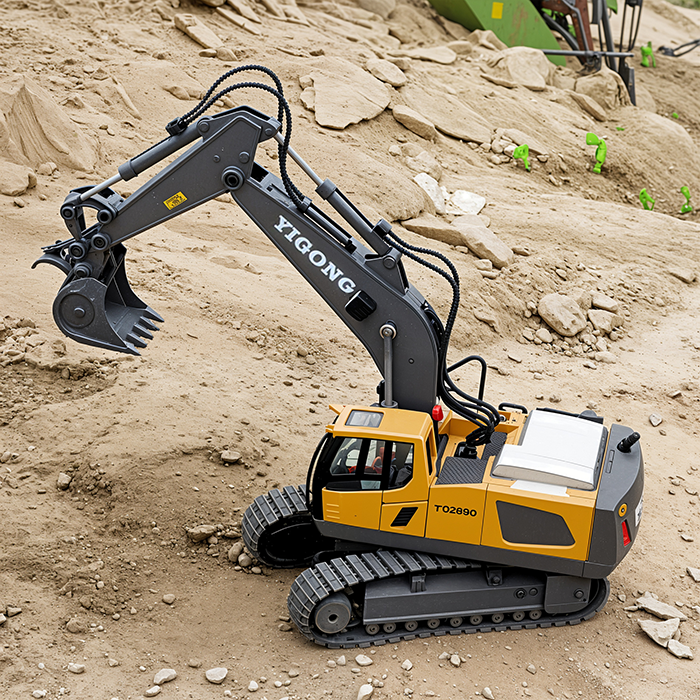How to Maximize Efficiency with a rc excavator in Site Grading
Wiki Article
The Necessary Features of Excavator That Make Things a Must-Have Device
Excavators are important in the building and landscape design markets. Their versatile accessories permit a variety of jobs, from digging to demolition. In addition, they boast superior digging depth and reach, powered by robust engines. Driver comfort and portable designs improve use in different environments. What truly sets excavators apart are their advanced hydraulic systems and sturdiness. Understanding these features can clear up why they are taken into consideration important tools on any kind of job site.Flexible Attachments for Improved Capability
Although excavators are powerful machines on their own, the addition of functional attachments significantly boosts their capability. These attachments change a basic excavator right into a multi-purpose tool, ideal for a variety of tasks. Pails, for example, come in various sizes and shapes, allowing operators to dig, scoop, and move materials efficiently. Hydraulic thumbs can be included for improved gripping and handling of cumbersome things, such as logs or rocks.Furthermore, specialized attachments like breakers and augers allow for boring and demolition work, broadening the excavator's utility on building sites. remote control excavator. Grapples are another option, perfect for relocating and sorting debris. This adaptability not only increases performance yet additionally minimizes the demand for several devices, saving time and costs. By gearing up excavators with the right attachments, drivers can take on varied jobs, making them crucial in the building and construction marketSuperior Digging Depth and Reach
Excavators are made with premium excavating depth and reach, allowing them to steer in limited rooms and gain access to hard-to-reach locations. This ability is vital for different construction and excavation tasks, where standard machinery might fall brief. With adjustable boom arms and extendable tracks, excavators can easily browse uneven surface while maintaining stability.The digging depth can differ considerably amongst models, typically varying from 10 to 25 feet, relying on the design and function. This feature makes it possible for drivers to dig deep into structures, trenches, and various other deep structures successfully. In addition, the reach of an excavator permits precise digging and product handling without repositioning the maker frequently, conserving time and labor costs.Ultimately, the superior digging deepness and reach of excavators make them essential for professionals looking for to complete complicated jobs with precision and efficiency. Their adaptability enhances productivity on task websites, showcasing them as a vital tool in contemporary building and construction.Powerful Engine Performance

Powerful engine performance plays a critical function in the abilities of an excavator when it comes to effectiveness and efficiency on building and construction websites. A durable engine generates substantial horsepower, enabling the device to take on durable jobs with simplicity - remote control excavator. This stamina equates into faster cycle times, allowing operators to total jobs extra quickly.Additionally, effective engines supply the needed torque to handle difficult terrains and varied lots, ensuring that the excavator can execute efficiently under different problems. Whether it is raising, digging, or moving products, the engine's efficiency directly impacts the overall functional efficiency of the machine.Furthermore, innovations in engine technology have actually caused enhanced fuel efficiency, reducing operational costs while keeping power result. Ultimately, the engine's efficiency acts as the foundation of an excavator, attesting its condition as a vital device in the construction sector
Advanced Hydraulic Solutions

Improved Lifting Capability
A significant enhancement in raising capacity can be credited to advanced hydraulic systems discovered in modern-day excavators. These systems make use of high-pressure fluid to create higher force, enabling operators to raise heavier tons effortlessly. The engineering behind these hydraulics guarantees peak efficiency, offering an outstanding power-to-weight proportion that improves total effectiveness. Consequently, excavators can deal with requiring tasks, such as raising large materials or tools, without jeopardizing stability. In addition, the durable design of hydraulic parts adds to increased sturdiness and integrity, making them ideal for numerous building settings. This enhanced training capacity not only minimizes the moment required for jobs but likewise decreases the requirement for extra equipment, showing essential for both efficiency and cost-effectiveness in the building sector.Enhanced Precision Control
Although standard excavators often battled with accuracy, modern hydraulic systems have transformed control systems, making it possible for drivers to execute tasks with amazing precision. These advanced systems utilize proportional control valves that enable smoother and much more receptive motions, substantially lowering the margin for error. Operators can now finely tune the excavator's activities, making it easier to navigate tight areas and take care of fragile products. Boosted feedback systems even more inform drivers of real-time performance, making sure optimal control between the maker and operator. remote control excavator This raised precision not just improves performance yet additionally boosts safety and security on task sites, reducing the risk of crashes. Therefore, contemporary excavators outfitted with innovative hydraulic systems are very useful tools for construction and excavation projects needing meticulous precision.Driver Comfort and Presence
Operator convenience and visibility are important elements in the design of modern-day excavators (remote control excavator). Functions such as ergonomic seat design, boosted visibility alternatives, and effective control layouts substantially enhance the driver's experience and performance. Prioritizing these facets assurances that operators can function successfully and securely in numerous problemsErgonomic Seat Design
Convenience and visibility are extremely important in excavator design, with the ergonomic seat playing an essential duty in enhancing the driver's experience. An ergonomic seat is engineered to sustain the driver's body, minimizing exhaustion during lengthy hours of operation. Flexible features, such as seat elevation, backrest angle, and back assistance, provide to individual choices and advertise ideal stance. These modifications improve convenience and enable the driver to preserve focus on jobs without discomfort. In addition, a well-designed seat can offer far better lateral assistance, permitting for smoother maneuvering when the excavator is in procedure. This thoughtful layout not only increases performance but also contributes to overall safety, guaranteeing that drivers can execute their tasks effectively and efficiently.Improved Exposure Functions
The layout of an excavator expands past just the seat, with improved presence attributes playing a considerable duty in driver comfort and total safety. Huge home windows and strategically located mirrors provide drivers with a clear view of their surroundings, reducing blind spots. This style consideration permits better spatial awareness, which is important in active workplace. On top of that, lots of excavators include rearview electronic cameras and progressed surveillance systems that aid drivers in navigating limited areas. The integration of these visibility features not just advertises safety however likewise minimizes driver fatigue by allowing less complicated tracking of workplace. Eventually, boosted exposure adds to extra efficient procedures and helps assure that excavators can execute their tasks properly and securely.Control Layout Effectiveness
While handling complicated work sites, an effective control format significantly enhances both driver convenience and visibility. A properly designed control setup warranties that operators can access essential features with minimal initiative, decreasing tiredness during lengthy hours. Ergonomic joystick positionings and user-friendly switch plans enable smooth operation, allowing operators to maintain focus on the job at hand. In addition, clear exposure of both the job area and the control panel is critical for security and accuracy. Modern excavators frequently integrate flexible seating and control setups to suit numerous driver preferences, better improving convenience. Eventually, an attentively created control layout not just boosts performance however additionally fosters a more secure working atmosphere by allowing operators to respond quickly to altering problems.Compact Style for Urban Environments
As city building sites usually encounter room restraints, a compact layout ends up being essential for excavators operating in these atmospheres. These equipments are engineered to navigate limited spaces, permitting for reliable ability to move in congested job sites. A lowered footprint enables them to function carefully to existing frameworks, decreasing disruption and taking full advantage of productivity.The compact style typically includes shorter tracks and a tighter turning distance, helping with operation in slim streets and confined areas. Light-weight materials add to relieve of transportation, making it less complex to move the excavator from one place to one more within the urban landscape.Additionally, numerous portable excavators are geared up with features such as versatile attachments and extendable arms, enhancing their performance while preserving a small dimension. This adaptability permits drivers to take on a selection of jobs, from excavating to demolition, all while fitting effortlessly right into the constraints of city atmospheres.
Sturdiness and Upkeep Considerations
Toughness stands as an important consider the efficiency and durability of excavators, especially popular metropolitan settings. These equipments undergo strenuous problems, consisting of differing dirt kinds, severe temperatures, and high-frequency usage. Premium products and durable construction are necessary for making certain that excavators can hold up against these challenges without endangering functionality.Regular upkeep is just as vital in preserving longevity. Scheduled evaluations, prompt oil adjustments, and the replacement of worn parts add substantially to an excavator's life expectancy. Operators needs to additionally pay interest to hydraulic systems, tracks, and undercarriages, as these parts frequently bear the impact of wear and tear.Investing in sturdy excavators with extensive maintenance plans boosts dependability and reduces downtime, inevitably bring about increased efficiency on building and construction sites. Recognizing the interaction in between resilience and upkeep is necessary for anyone considering the acquisition of an excavator for city projects.Regularly Asked Inquiries
How Do Excavators Compare to Other Building Devices?
Excavators attract attention among construction equipment due to their adaptability, enabling tasks such as grading, digging, and lifting. Contrasted to others, their hydraulic capabilities supply greater effectiveness and power, making them crucial on numerous work sites.What Safety And Security Features Are Consisted Of in Modern Excavators?
Modern excavators integrate different security features, including rollover defense systems, alarms, and advanced visibility improvements. These components collaborate to reduce threats, ensuring operator safety while improving performance on building and construction websites and other requiring environments.
Can Excavators Be Made Use Of in Wintertime Issues?
Excavators can certainly be utilized in winter months problems, provided they are equipped with suitable winter season accessories and precautions are taken. Correct maintenance and modifications improve their performance, guaranteeing effective procedure regardless of difficult climate conditions.What Is the Ordinary Life-span of an Excavator?
The average lifespan of an excavator typically ranges from 7,000 to 10,000 hours of procedure. This period can substantially depend on upkeep techniques, operating conditions, and the specific version's resilience and layout features.Exactly how Do I Select the Right Excavator Dimension for My Project?
Selecting the appropriate excavator dimension involves reviewing task scope, site problems, and material kinds. Take into consideration elements like reach, deepness needs, and weight capability to assure optimal efficiency and safety throughout operation. Dimension issues significantly in task success. Additionally, the reach of an excavator enables for accurate excavating and material handling without rearranging the equipment regularly, conserving time and labor costs.Ultimately, the remarkable excavating depth and reach of excavators make them indispensable for professionals looking for to complete complex tasks with accuracy and efficiency. Convenience and exposure are extremely important in excavator style, with the ergonomic seat playing a vital role in boosting the operator's experience. The design of an excavator prolongs beyond simply the seat, with boosted visibility features playing a significant duty in driver convenience and total safety and security. Modern excavators typically include flexible seats and control settings to fit different operator preferences, even more enhancing convenience. Lightweight products contribute to ease of transport, making it less complex to relocate the excavator from one location to an additional within the city landscape.Additionally, lots of compact excavators are equipped with features such as extendable arms and versatile add-ons, enhancing their capability while maintaining a tiny size.Report this wiki page